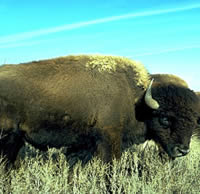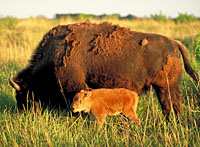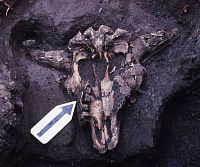Bison (Bison bison)
This animal, known more commonly as buffalo, was only present in the region during certain, widely separated, periods in prehistoric times. The Edwards Plateau is on southern periphery of the Southern Plains and thus on the southern periphery of bison habitat; most of the time. Bison did range across the region prior to 9,000 B.C. and during several widely-separated periods thereafter. The best known “bison presence” is the Toyah interval during the final centuries of prehistory (about A.D. 1300-1600) and into the 17th-19th centuries. Such periods apparently coincided with wetter climatic conditions that favored the expansion of grasslands in the region. Such climatic intervals may have coincided with periods during which the Central Plains was suffering from drought, thus triggering the movement of bison into the regionally greener pastures. The details of bison movements into the region are poorly understood.
What we can say is that bison were absent from most of the region during most of the last 10,000 years and were not a “normal” part of prehistoric life. Bison herds probably ranged into the far northwestern Edwards Plateau somewhat more commonly, but this area was at the southern extent of their normal range. When bison entered the region proper, local peoples must have done everything in their power to take advantage of the reappearing resource. Hunting patterns, hunting methods, group movements, and many other aspects of life would have been altered and it is likely that “foreign” groups from outside the region followed the bison herds. So we can think of bison as an intermittent, atypical resource in the prehistory of the region.
![]()


